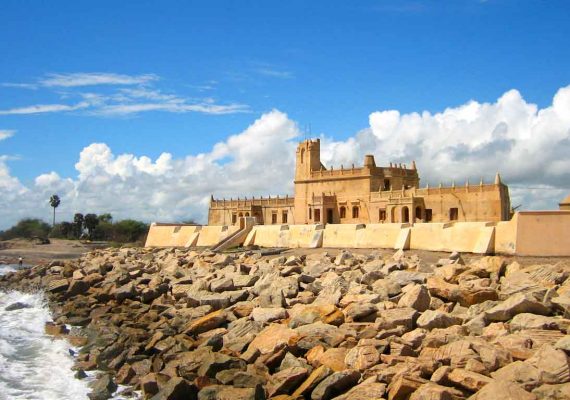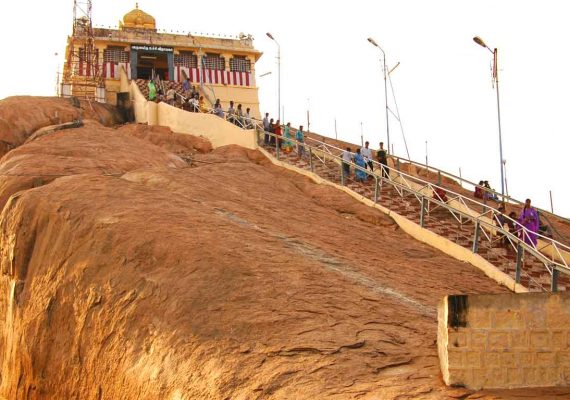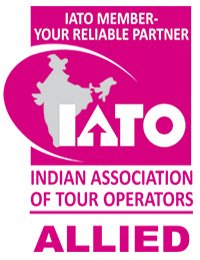Booking for : Best of South India
Best of South India
Tour Details
TOUR INFO:
South India is a region in the southern part of India. It includes the states Andhra Pradesh, Karnataka, Kerala and Tamilnadu. It also houses the Union Territory Pondicherry(Puducherry) and Lakshadweep Island in the Arabian Sea. The Godavari, Krishna, Tungabhadra and Kaveri rivers are important non-perennial sources of water. Southern region speak one of the Dravidian languages: Kannada, Malayalam, Tamil, Telugu, and Tulu. The classical dances of India like “Bharat Natyam” and “Kathakali” have South Indian origin.
This part of India has enormous beaches, water falls, forests, lakes, backwaters, Wild Life Sanctuary etc. The famous cities in this region are Hyderabad and its twin city Secunderabad, Mysore, Bangalore (Bengaluru), Kochi (Cochin), Trivandrum (Thiruvananthpuram), Chennai (Madras), Kanyakumari (Nagercoil)etc. Some of the famous hill stations in this region are Kodaikanal, Ooty (Ootacamund), Munnar etc.
HIGHLIGHT: Chinese fishing nets and Kathakali dance of Cochin, the lush tea gardens of Munnar, the wildlife of Periyar (Thekkady), back waters of Alleppey and pristine beaches of Kovalam.
BEST TIME TO TRAVEL: October – March
Day 01 Arrive Chennai and drive to Mahabalpuram (60 kms/01 hr). P.M. SS tour.
Day 02 Day tour of Kanchipuram and back to Mahabalipuram.
Day 03 Drive to Pondicherry (120 kms/03 hrs).
Day 04 SS tour.
Day 05 Drive to Tanjore (170 kms/04 hrs). P.M. SS tour.
Day 06 Drive to Chettinad (80 kms/01 ½ hr)
Day 07 Drive to Madurai (80 kms/01 ½ hr). P.M. SS tour with aarti ceremony.
Day 08 Drive to Periyar (140 kms/03 ½ hrs). P.M. Visit Spice Plantation.
Day 09 Morning boat ride. P.M. Nature walk
Day 10 Drive to Alleppey (140 kms/04 hrs). O/N in House boat.
Day 11 Drive to Cochin (70 kms/01 ½ hrs). P.M. Kathakali dance show.
Day 12 SS tour.
Day 13 Depart Cochin.
Day 01,Arrive Chennai – drive to Mahabalipuram/SS tour
Upon arrival in Chennai airport, you will be welcomed by Kipling India Representative who will meet and greet and then drive to Mahabalipuram. Upon arrival in hotel, he will brief you about the tour and handover the travel documents. Afternoon visit – Arjuna Penance - Arjuna’s Penance is one of the magnificent monuments of Mahabalipuram. This wonderful bas air relief dates back to the mid-seventh century. Standing tall at a height of 43 feet, the monolith was carved on the face of two huge adjoining boulders, making its length around 96 feet. The majestic structure cannot be made out in photographs, it deserves to be praised by one’s own eyes. Five Rathas - Panch Rathas is a monument complex at Mahabalipuram. The coastal city along the shores of Bay of Bengal was a major seaport of the ancient Pallava kingdom. It is currently one of the magnificent UNESCO World Heritage sites. The Panch Rathas are five rock marvels in the monument complex. It is known for its, 'rathas' or monolithic rock temples cut out in the form of chariots. Shore Temple - The Shore Temple is the icon of the ancient monuments of Mahabalipuram. The temple gets its name from its location on the Coromandel shore overseeing the Bay of Bengal. The sculptural excellence symbolizes the heights of Pallava architecture. The Dravidian style of architecture dates back to the 7-8th century. It was built under the rule of King Narsimha Varma. The visual delight of finest architecture, the sculptures and intricate and full of vivacity.
Day 02,Mahabalipuram – Kanchipuram – Mahabalipuram
After breakfast, drive to Kanchipuram. Kanchipuram, amongst the seven sacred cities of India, is a paradise of beautiful temples nestled on the banks of the River Vedavathi in the Indian state of Tamil Nadu. With a great number of shrines, it is no surprise that the town is an illustrious pilgrimage site for Hindu devotees. In addition to these, the place also boasts of several famous mosques and churches. Visit Ekambaranathar temple - The Ekambaranathar Temple in the city was built by the Pallavas and was later reconstructed by the Chola and Vijayanagar kings. Shiva is worshiped here as Prithvi (earth), one of the five basic elements of the physical world. The dimensions of the temple are reflected in its 20-acre spread and its tall south Gopuram, which soars to a height of 58.5 m. The temple has 11 stories and one of the tallest temple towers in South India. The structure is decorated with beautiful sculptures. Kanchipuram is also famous for its silk where the guests will be taken to seen the Silk Handloom. Later drive back to Mahabalipuram.
Day 03,Mahabalipuram – Pondicherry
After breakfast, drive to Pondicherry. Pondicherry, also known as Puducherry and commonly referred as just Pondy, is one of the seven Union Territories of India. is often famously referred to as the French Riviera of the East, and it is indeed one of the most charming and mesmerising places to visit in South India. Located in the state of Tamil Nadu, Pondicherry is a little town tucked away on the south-east coastline of India, and it is a destination that promises travellers sanctity and serenity, in the real sense of the terms. Upon arrival, check in at your hotel. Rest of the day free to relax.
Day 04,Pondicherry
After breakfast, proceed to visit Aurobindo Ashram –The Sri Aurobindo Ashram located on Rue de la Marine, is one of the most well-known and wealthiest ashrams in India, with devotees from India and all over the world flocking towards it for spiritual salvation. Its spiritual tenets represent a synthesis of yoga and modern science. Auroville – or the City of Dawn was conceived as a place of research into the ideal of human unity by the Mother, the spiritual collaborator of Sri Aurobindo. The idea is to build a futuristic city where people of goodwill can live together in peace and progressive harmony, above all creeds, all politics and all nationalities. This place came to existence in 1968. The Matri Mandir - The Matrimandir (Sanskrit for Temple of The Mother) is an edifice of spiritual significance for practitioners of Integral yoga, situated at the centre of Auroville initiated by The Mother of the Sri Aurobindo Ashram. It is called soul of the city and is situated in a large open space called Peace. Matrimandir does not belong to any particular religion or sect. Sacred Heart of Jesus - Basilica of the Sacred Heart of Jesus situated on the south boulevard of Pondicherry in Puducherry, India, is an oriental specimen of Gothic architecture. It contains rare stained glass panels depicting events from the life of Christ and saints of the Catholic Church.[1] In recent years it has become one of the famous pilgrimage spots for Christians. Norte Dame – The church of Our Lad of Angels stands in the former Capuchins square, surrounded by the streets Dumas, Surcouf and Romain Rolland. Between the church and the sea lies a little garden, in the middle of which stands a statue of Joan of Arc, armored and carrying a battle standard. The statue and the garden bearing her name, were acquired and gifted by Francois Gaudart in 1919.
Day 05,Pondicherry – Tanjore
After breakfast, drive to Tanjore. Thanjavur properly situated in the Cauvery delta is the rice – bowel of Tami Nadu. A fertile land that was also fertile for art, architecture and culture. Though it was a famous city from early times, its importance was fully understood only by the later Cholas (AD 846 – 1276) who built an empire making it their capital. It was Vijayalaya who founded the later Chola Kingdom here and Rajaraja the Great (AD 984 – 1014) and his son Rajendra I (AD 1012 - 1044) were the real architects of the Chola empire that held sway over India upto the Ganges in the north and held colonies in Myanmar, Malaya and the East Indies. Upon arrival, check in at your hotel. Afternoon proceed to visit : Brihadeeshwara Temple - A study in Oriental architecture or history is certainly incomplete without a mention of the Tanjore Brihadeeshwara Temple or the Tanjore Periya Kovil (Big Temple). This imposing structure was built by Raja Raja Cholan and his sister Kundavai, both ardent devotees of Lord Shiva. It was constructed by the King at the height of the Chola reign to signify his power and strength. Tanjore Palace - The original name of Thanjavur Palace is Sivaganga Fort, which is rarely used these days. If you observe carefully, there is even a small moat around it which provided security against enemy access. Often mistakenly called the "Thanjavur Maratha Palace" was not built by Maratha Kings, but by Thanjavur Nayaks. However, the Marathas made some enhancements to suit their needs. It is more popularly called "Thanjavur Aranmanai" by the people of Tamil Nadu.
Day 06,Tanjore – Chettinad
After breakfast, drive to Chettinad. The origin of Chettinad begins in the 13th century when the Nattukottai Chettiars migrated to Karaikudi. They left their previous area, the Cauvery Poompattinam, following a massive flood. The new settlement eventually became the Chettinad region (Land of the Chettiars) of 96 villages (in 1947) over a 600-1500 square mile area, out of which around 75 villages still exist today. Starting as traders, the Chettiar’s travels took them to various states in South East Asia, such as Sri Lanka, Singapore, Burma, Cambodia, Vietnam and Malaysia. Upon arrival, check in at your hotel. Rest of the day free at leisure.
Day 07,Chettinad - Madurai
After breakfast, drive to Madurai. Madurai is one of the oldest continuously inhabited cities in India. Situated on the banks of Vaigai river in Tamil Nadu, the city is known for its Meenakshi Sundareswarar Temple. Apart from being a pilgrim town, a popular tourist destination, a cultural hotspot and the erstwhile capital of the Pandyan dynasty Madurai is also known for its food, cuisine, architecture, shopping and endearing people. Upon arrival, check in at your hotel. Afternoon visit : Meenakshi Temple - The Meenakshi Temple, a must-see south Indian temple, is the focal point of Madurai. Apparently, the city was built around the Shiva lingam that's inside its sanctum. The temple complex covers 15 acres, and has 4,500 pillars and 12 towers. You could easily spend days in there, as it's a "living temple" with a lot going on inside, including a constant stream of couples waiting to be married in its corridors. Tirumalai Nayak Palace - Tirumalai Nayak Palace is Madurai's second biggest attraction. King Thirumalai Nayak built it as his residential palace in 1636, with the input of an Italian architect. It's a classic fusion of Dravidian and Islamic styles. The palace's distinguishing feature is its pillars and there was once more than 200 of them. Vandiyur Mariamman temple - Vandiyur Mariamman temple is located near to river Vaigai, in the east of Madurai, at a distance of 3 kms from the famous Meenakshi temple. Although Mariammam Shrine is the prime shrine, the temple has also goddess Pechi ammam and Lord Ganesh beside the Peepul tree. It is an ancient temple which is 2000 years old. The moolavar here is Mari Amman and the sacred water is the teppakulam. Evening proceed to witness the Aarti ceremony.
Day 08,Madurai – Periyar (Thekkady)
After breakfast, drive to Periyar. The very sound of the word Thekkady conjures up images of elephants, unending chains of hills and spice scented plantations. The Periyar forests are one of the finest wildlife reserves in India. Spreads across the entire district are the picturesque plantations and hill towns that nestle beautiful trails for treks and mountain walks. Upon arrival, check in at your hotel. Later visit Spice Plantation – This visit hosts some of the finest spice plantations in the country. Its equable climate and unique geographical positions has helped it become the de facto exporter of spices in the State. These spices are used by millions to add flavour to food along with helping preserve it. Other spices like turmeric and ginger are known to be used for medicinal purposes and religious rituals.
Day 09,Periyar
Early morning proceed for boat ride in the Periyar Lake. During this boat ride one can see herds of elephants grazing near the edges of the shoreline. Deer, sambar, gaur and wild boars can be seen flocking around the place at regular intervals. A majority of the wildlife activity in the area can be viewed during the summer months of March and April. Darters, egrets and kingfishers can be seen flocking around the withered trees that rise out of the lake. It is a surreal experience that is highly recommended if you are in the area. Back to hotel for breakfast. Whole day free at leisure. In the later afternoon proceed for nature walk with an experience guide through different nature trails in this programme. The trekking through diverse terrain gives visitors a ringside view of the forest. Though it is difficult to spot many wild animals, trekkers will definitely get to see varieties of birds and butterflies and some animals. The trail passes through evergreen forests and moist, deciduous forests, interspersed with marshy grasslands.
Day 10,Periyar – Alleppey
After breakfast, drive to Alleppey. Built in the 9th century AD, Alleppey, called Alappuzha lies on the edge of the great Ashtamudi Lake. With the Arabian Sea on the west and a vast labyrinth of lakes, lagoons and several freshwater rivers criss-crossing it, Alappuzha is a district of immense natural beauty. Related to the Venice of the East by travellers from around the world, this Backwater Country is also home to diverse range of animals and birds. It has always been honored a unique place in the maritime history of Kerala for its proximity to the sea. Alleppey has earned fame in the commercial world as the world's premier supplier of coir. Upon arrival, check in house boat and start sailing through the narrow canal of the backwaters. Lunch will be served in the house boat. Later in the evening around 1700 hrs, the houseboat will be docked. One can embark from the boat and take a walk through the villages. Back to house boat for dinner and overnight.
Day 11,Alleppey – Cochin
After breakfast, drive to Cochin. Initially, Kochi was an obscure fishing village that later on became the first European township in India. The town was shaped by the Portuguese, the Dutch and later the British. The result of these cultural influences are seen in the many examples of Indo European architecture that still exist here. Upon arrival, check in at your hotel. Late afternoon proceed to witness the Kathakali dance show. ‘Kathakali’, an important genre in the Indian classical dance form, is associated with storytelling form of this art. It is the dance drama from the south Indian state of Kerala. Similar to other Indian classical dance arts, the story in ‘Kathakali’ is also communicated to audience through excellent footwork and impressive gestures of face and hands complimented with music and vocal performance.
Day 12,Cochin
After breakfast, proceed for sightseeing tour. First visit St. Francis Church - The St. Francis Church, well-known for its beautiful structural design and ambience, has an important place in history. It is here that the famous explorer, Vasco-da-Gama, was originally buried. His remains would be taken back 14 years later but to this day, the exact spot is clearly marked. The place is known for its deep Dutch and Portuguese influences and is an architectural marvel in itself. Chinese Fishing Nets ¬-Legend has it that the famous Chinese explorer, Zheng He, introduced the Chinese Fishing Nets to the fishermen in Kochi over 500 years ago. Even though he would leave, these would become staple sights in these parts. The Chinese fishing nets,or Cheenvala for the locals, have attracted visitors in the Fort Kochi area for centuries. Dutch Palace - The Mattancherry Palace is located about 12 km from Ernakulam. One of the finest examples of the Kerala style of architecture mixed with colonial influences, the Portuguese built it as a gift to King Veera Kerala Verma. It came to be known as the Dutch Palace as it underwent major repairs at the hands of the Dutch. It is among the most popular tourist destinations in the Fort Kochi area. Jewish Synagogue - A short walk from Mattancherry bus stand or from the boat jetty nearby would take you to the Jewish Synagogue, situated at one end of the Jew Street in the Jew Town enclave of Mattancherry in Fort Kochi. This synagogue was built in 1568 by the Malabar Yehudans or Cochin Jewish community. It was built close to the Mattancherry Palace Temple on the land gifted by King Rama Varma, a former ruler of Kochi. Rest of the day free at leisure.
Day 13,Depart Cochin
Final departure transfer to Trivandrum airport to board your flight for onward journey.











